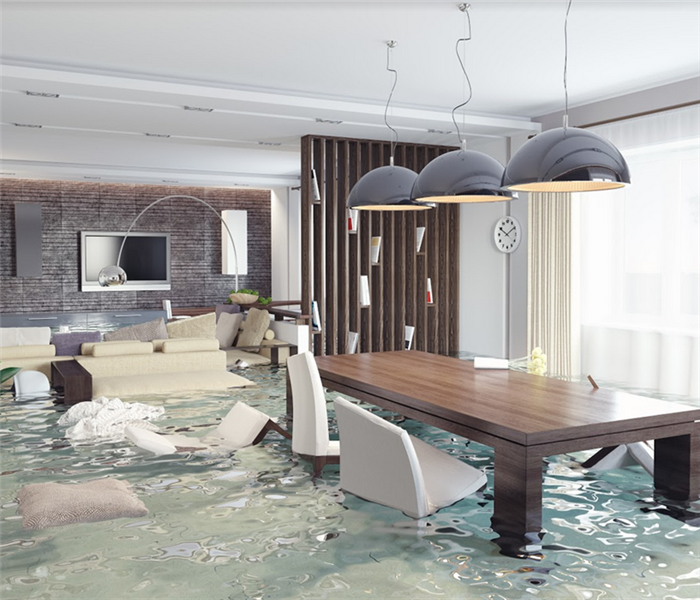What Are Some of the Hazardous Waste Complications Possible During Waterbury Flooding Cleanup?
9/27/2020 (Permalink)
 Flooding can bring debris waste into your home. Contact Team SERVPRO for effective water removal efforts immediately.
Flooding can bring debris waste into your home. Contact Team SERVPRO for effective water removal efforts immediately.
Contaminated Water and Broken Down Building Materials Pose Significant Flood Damage Challenges for Waterbury Homeowners -- SERVPRO Offers Effective Solutions
The summer and fall months in Waterbury always hold the possibility of severe weather and sometimes shocking levels of harm to residential property linked to the hurricane season or training thunderstorms from the southwest. Torrential rain and destructive winds, including the potential for tornadoes, move across the landscape, with violent energy impossible to avoid. Rain collects and then flows over pavement, fields, and lawns. Rivers and smaller waterways can overflow their banks, adding to the mix of fluids that eventually make their way into your home's foundation. Exterior damage allows water to invade from the roof level down, saturating materials and possibly causing structural collapse risks when the fluids pool up in building cavities.
What Category Is the Water Flooding Portions of Your Home?
Flood damage in Waterbury as elsewhere is typically caused by wind and rain exterior damage or overland water flow. When the flood waters pick up debris as they move over flat and sloping surfaces, relatively clean rain water picks up:
- Industrial wastes, including all manner of chemical depending on the worksite
- Organic debris, including vegetation and dead animals and insects
- Oils and gasoline from roads and sidewalks, along with loose gravel, sand, mud, and paving compounds
- Sanitary sewer overflow, which can be exacerbated by a backup of human waste in from your sewer line inside you lower levels
When all the different contaminants mix together, it swiftly becomes evident why flood water is, by definition, considered Category 3, or the most dangerous type of water loss. It is inadvisable for a layperson to try to manage this toxic concoction. Contact with skin or inhalation can irritate at a minimum. The risk of exposure to human pathogens that can sicken or even put one's life at risk can be significant and must be considered a substantial threat to health or well-being.
Are Any Other Sources of Contamination Common During Flood Damage?
SERVPRO crews assess more than the damage done by foundation level flooding in Waterbury. Water streaming in from the roof or other exterior components crushed, cracked open, or otherwise compromised by wind, falling trees or branches, or additional windborne debris is also a contributor to the sodden mess inside. If water from the roof or other damaged materials collects in building cavities, collapse can be imminent. When this happens, formerly intact and encapsulated structures containing biohazards like asbestos and lead become urgent issues. These highly toxic minerals and heavy metals can cause illness and developmental concerns when ingested or inhaled. Specially trained and certified technicians from our team must take on the remediation of surfaces, spaces, air, and water contaminated with these substances.
How Are the Contaminants Managed and Discarded Safely and Lawfully?
After we locate the contaminated water, structures, and debris, specific research-based and legally regulated protocols guide our next steps. Generally, we create a safe working environment by considering building contained areas within which to collect, bag, and off-load the hazardous flood water and solids:
- We construct partitions constructed of 1.6 mil polyethylene and conduit
- We seal the smaller chambers through the action of negative pressure air scrubbers
- Preventing the drift or flow of hazardous substances into unaffected spaces inside your home
- Forcing any airborne contaminants through the HEPA filters of the air scrubber before venting to the outdoors
- We encapsulated and bag solid debris for disposal.
- Our team keeps abreast of local laws, regulations, and rules pertaining to the biohazards involved.
- We complete the needed disposal for our customers, obtaining and completing any necessary paperwork.
How Do Professionals Contain the Contaminated Flood Waters that Rang the First Alarm for You as a Homeowner?
If we use submersible pumps as an early intervention for deep water, we discharge the fluids into treated sewer lines. Our truck-mounted units can extract the bulk of the liquid water. These onboard tanks can hold in excess of 100 gallons, and the contained flood water is then transported to the appropriate hazardous waste disposal site. If portable extractors also suction out water in confined areas, we add those quantities to the captured flood water for disposal.
Is Water Removal the Final Step to Flood Damage Remediation?
After evacuation of the liquid water, we use EPA-registered cleaners and disinfectants to remove soiling and kill lingering pathogens. Our Applied Structural Drying (ASD) technicians determine drying goals based on testing of wet materials for moisture levels as compared with similarly situated dry structural components. We balance air movement, temperature, and humidity to bring wet materials to normal moisture levels using professional grade air movers, heaters,and dehumidifiers.
The highly-qualified managers and technicians from SERVPRO of Waterbury are ready when flood damage exposes your family to more than just a torrential rain runoff. We have the skills and knowledge to abate a range of hazards presented while we rid your home of water and lingering moisture. Call (203) 757-5050 day or night to explore how we can help.






 24/7 Emergency Service
24/7 Emergency Service